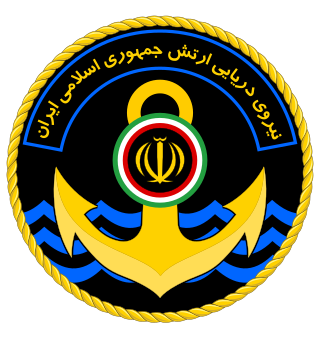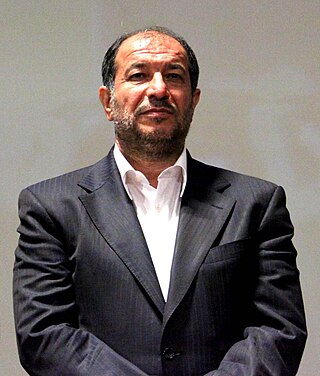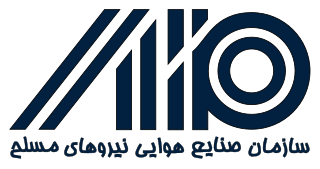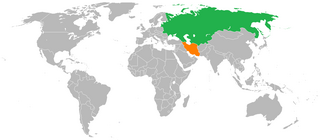
The Islamic Republic of Iran Navy or Iranian Navy, officially abbreviated NEDAJA, is the naval warfare service branch of Iran's regular military, the Islamic Republic of Iran Army (Artesh). It is one of Iran's two maritime military branches, alongside the Navy of the Islamic Revolutionary Guard Corps (IRGC).

Mostafa Mohammad Najjar is an Iranian politician and retired IRGC general. He was interior minister of Iran from 2009 to 2013 and minister of defense in the first cabinet of Mahmoud Ahmadinejad from 2005 to 2009. He is also a veteran of the IRGC.
The military industry of Egypt produces defense and security products including small arms, armored vehicles, and naval vessels for the Egyptian Armed Forces. Equipment is also exported. Egypt has co-production agreements with several countries, including the United States and France.
The military history of Iran has been relatively well-documented, with thousands of years' worth of recorded history. Largely credited to its historically unchanged geographical and geopolitical condition, the modern-day Islamic Republic of Iran has had a long and checkered military culture and history; ranging from triumphant and unchallenged ancient military supremacy, affording effective superpower status for its time; to a series of near-catastrophic defeats, most notably including the ancient Greek kingdom of Macedon as well as the Asiatic nomadic tribes at the northeastern boundary of the lands traditionally home to the Iranian peoples.
Iran's military industry manufactures and exports various types of arms and military equipment. Iran's military industry, under the command of Iran's Ministry of Defence and Armed Forces Logistics, is composed of the following main components:

The Fajr-3 is an Iranian heavy 240 mm intermediate-range multiple-launch artillery rocket (MLRS). The Fajr-3 is a license-built copy, with slight modifications, of a North Korean MLRS called the M-1985. The Fajr-3 was introduced in the 1990s and has since been exported to Syria, Hamas and Hezbollah.

Iran Electronics Industries or Integrated Electronics Industries(IEI, Persian: صنایع الکترونیک ایران; also known as Persian: صاایران, Sâiran) is a state-owned subsidiary of Iran's Ministry of Defense. It is a diversified organization with operations in electronics, optics, electro-optics, medical equipment, communications, computer and semiconductors.

The Raad or RAAD is an Iranian wire-guided anti-tank guided missile based on the Soviet 9M14M Malyutka missile. The Raad began mass production in 1988 and was publicly unveiled in 1997. It is manufactured by Parchin Missile Industries, a subsidiary of Iran's Defense Industries Organization.

The Toophan is an Iranian SACLOS anti-tank guided missile reverse-engineered from the American BGM-71 TOW missile. The Toophan 1, an unlicensed copy of the BGM-71A TOW missile, began mass production in 1988 and the Toophan 2, a BGM-71C ITOW variant, was publicly shown in 2000.
The Defence Industry of Pakistan, established in September 1951, mainly falls under the purview of the Ministry of Defence Production (MoDP). It aims to foster collaboration and oversee the diverse range of military production facilities that have emerged since Pakistan's independence. The MoDP comprises specialized organizations, each dedicated to various aspects of the defence industry, including research and development, production, and administration.

The Iran Aviation Industries Organization (IAIO), also known as the Aerospace Industries Organization, is an Iranian state-owned corporation established in 1966 for the purpose of planning, controlling, and managing the civil & military aviation industry of Iran. The Aerospace Industries Organization acts as both an OEM, directly manufacturing aircraft and aerospace products, and as a conglomerate, holding other Iranian state-owned aviation corporations.

The Iranian Armed Forces, officially the Islamic Republic of Iran Armed Forces, are the combined military forces of Iran, comprising the Islamic Republic of Iran Army (Artesh), the Islamic Revolutionary Guard Corps (Sepah) and the Law Enforcement Command (Faraja).

The policy of the Soviet Union towards the Iran–Iraq War from 1980 to 1988 varied, beginning with a stance of "strict neutrality" and moving towards massive military support for Iraq in the final phase of the war. The war was inconvenient for the USSR, which had aimed to ally itself with both Iran and Iraq. In the first period of the war, the Soviets declared a policy of "strict neutrality" towards the two countries, at the same time urging a negotiated peace. Iraq had been an ally for decades and the Soviets had tried to win over Iran as well, but their offers of friendship were rebuffed by both the pro-Western Shah and the Ayatollah of Iran. After the Iranian revolution, the Islamic Republic established its slogan as "neither East nor West." In 1982, the war turned in Iran's favor and the Iranian leader Ayatollah Khomeini pledged not to stop the conflict until he had overthrown the Iraqi president Saddam Hussein. Such a prospect was unacceptable to the Soviet Union, which now resumed arms sales to Iraq while still maintaining an official policy of neutrality. The Soviets also feared losing Saddam's friendship with the West. After further Iranian gains in 1986, the Soviet Union massively increased its military aid to Iraq. The Soviets were now afraid of the Iranians encouraging Islamic revolution in Central Asia. Soviet aid allowed the Iraqis to mount a counteroffensive which brought the war to an end in August 1988.

Israel supported Iran during the Iran–Iraq War. Israel was one of the main suppliers of military equipment to Iran during the war. Israel also provided military instructors during the war, and in turn received Iranian intelligence that helped it carry out Operation Opera against Iraq's Osirak nuclear reactor. The nuclear reactor was a central component of Iraq's nuclear weapons program.

The Ministry of Defence and Armed Forces Logistics is the defence ministry of Iran and part of the country's executive branch. It thus reports to the President of Iran, not to the Commander-in-Chief of the Iranian Armed Forces.

The Imam Hossein Comprehensive University is a public university located in Tehran, Iran.

Mohammad Reza Pahlavi, commonly referred to in the Western world as Mohammad Reza Shah, or simply the Shah, was the last monarch of Iran (Persia). In 1941 he succeeded his father Reza Shah and ruled the Imperial State of Iran until 1979 when the Iranian Revolution overthrew him, abolished the monarchy and established the Islamic Republic of Iran. In 1967, he took the title Shahanshah, and also held several others, including Aryamehr and Bozorg Arteshtaran. He was the second and last ruling monarch of the Pahlavi dynasty. His vision of the "Great Civilization" led to his leadership over rapid industrial and military modernization, as well as economic and social reforms in Iran.

Malek Ashtar University of Technology (MUT) is a public research university of engineering, science in Iran. Founded in 1984, MUT's main campus is located at Tehran, the capital of Iran. Its other campuses are located in Isfahan and Urmia. The university is named after Malik al-Ashtar, one of the most loyal companions of Ali Ibn Abi Talib.

The Imperial State of Iran, officially known in English as the Imperial State of Persia until 1935, and commonly referred to as Pahlavi Iran, was the Iranian state under the rule of the Pahlavi dynasty. The Pahlavi dynasty was created in 1925 and lasted until 1979, when it was ousted as part of the Islamic Revolution, which ended the Iranian monarchy and established the current Islamic Republic of Iran.
















